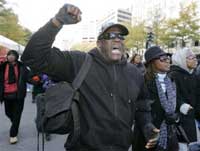Anti-racist March to Justice circles ‘Justice’ Department
By
Steven Ceci
Washington, D.C.
Published Nov 21, 2007 10:41 AM
Thousands of people from around the country came to Washington, D.C., on Nov.
16 and marched to demand an end to police brutality, racial profiling and hate
crimes. The call for the March to Justice came from Rev. Al Sharpton’s
National Action Network.
|
March to Justice Nov. 16.
|
Organizers said that more than 100 buses came from as far away as Florida and
Michigan for the march, which was on a workday. The marchers circled the huge
Justice Department building.
One focus of the march was the case of the Jena Six—six Black youth from
Jena, La. After a noose was hung from a tree at the local high school, the six
were charged with attempted murder for a schoolyard fight in which they stood
up against racist terror. One, Mychal Bell, is still in prison despite a
nationwide campaign around the case.
Several marchers cited the death earlier this week in Brooklyn of 18-year-old
Khiel Coppin in a barrage of police bullets. “We’re tired of Black
people being targets for the police,” said Page Sterling, 71, a marcher
from Richmond, Va.
Speakers at the rally included Rep. Sheila Jackson Lee, Rev. Martin Luther King
III and Rev. Al Sharpton. Rev. Lennox Yearwood of the Hip Hop Caucus linked the
struggle against racism to the struggle against the war in Iraq.
Marchers chanted “No justice, no peace—What do we want? Justice.
When do we want it? Now!” The march was very spirited and militant. Many
marchers said they will be back and that the struggle against racism is growing
into a new civil rights movement.
The march was organized in three weeks and the turnout was due in large part to
announcements by Black radio disc jockeys such as Tom Joyner, Steve Harvey and
Michael Baisden, all of whom have syndicated radio shows. This was similar to
the way in which large sections of the immigrant population were mobilized to
turn out in huge numbers for a march for immigrant rights in 2005.
Articles copyright 1995-2012 Workers World.
Verbatim copying and distribution of this entire article is permitted in any medium without royalty provided this notice is preserved.
Workers World, 55 W. 17 St., NY, NY 10011
Email:
[email protected]
Subscribe
[email protected]
Support independent news
DONATE


